Looking for Expert-Level VA Claim Answers?📱Call Us Now! 737-295-2226
I think I know why you clicked this blog post: You currently have a 90 percent VA disability rating and want to know how to increase it to 100 percent.
It makes total sense because the tax-free compensation and benefits available to you at the VA 100% rating level are markedly different than those available at the 90% VA rating level.
Getting a 100% VA rating could qualify you and your family for some amazing 100 percent VA disability benefits worth hundreds of thousands of dollars, maybe even millions of dollars.
For example, a 90 percent VA rating in 2023 is worth a minimum of $2,172.39 per month whereas a 100 percent rating is worth a minimum of $3,621.95 per month.
Thus, a 100% VA disability rating is worth an extra $1,449.56 each month versus the 90% rating!
So strap-in, I’m going to reveal the 3 best ways to increase your 90 percent VA rating to 100 percent, even if you’ve already filed your claim, been denied, or gave up.
Deserve a HIGHER VA Rating? WE CAN HELP.
Join our premier education-based membership program, VA Claims Insider Elite, connect with an expert-level Veteran Coach (VC) within minutes, and finally get the rating you deserve. Click the button below to get started.
- 90 to 100 Percent VA Rating Increase: The 4 Essential Elements for VA Disability Claims
- I Have 90 Percent VA Disability How to Get 100 Percent?
- How to Get From 90 to 100 VA Disability Path #1. File for Increased Disability on Conditions Already Service Connected
- 90 Percent VA Disability Increase Path #2. File for New Primary Disability Conditions for Direct Service Connection
- How to Go From 90 to 100 VA Rating Path #3. File for New Secondary Disability Conditions for Secondary Service Connection
- How to Increase My VA Disability Rating Path #4. File a Supplemental Claim for Previously Denied Disability Conditions
- Path #5. File for Presumptive Disability Conditions
- Increase VA Rating From 90 to 100 Percent Path #6. File for Total Disability Individual Unemployability (TDIU)
- Want to Increase Your 90 VA Disability to 100% (Without the Pain of Fighting the VA for Years?)
- About the Author
90 to 100 Percent VA Rating Increase: The 4 Essential Elements for VA Disability Claims

There are four (4) essential elements you must prove to get your VA disabilities service connected, rated, or increased.
We call it: “The VA Claims Insider Golden Circle.”
- (#1) Medical diagnosis of a disability condition.
- (#2) Evidence of an in-service event, injury, disease, or aggravation.
- (#3) Nexus (or link) between #1 and #2 via competent medical evidence, such as a Nexus Letter.
- (#4) “Severity of Symptoms” in terms of frequency, severity, and duration.
I Have 90 Percent VA Disability How to Get 100 Percent?

If you have a 90% VA disability rating, and are trying to increase your VA rating to 100%, here are the 3 best ways to get there:
There are three main ways to get from 90 to 100 VA disability:
- If the VA’s “fuzzy math” calculation puts you at or above 95.00% or higher, the VA will round you up to 100% rating.
- If one of your conditions gets rated at 100% out of the gate. For example, your PTSD is rated individually at 100%, so your six other rated disabilities might not even come into play.
- If your disability renders you unable to maintain substantial gainful employment, you may receive the pay and benefits of a 100% VA rating—even if your combined VA rating is below 100%. For example, a Vietnam veteran might have a 70% rating because they suffer from cancer due to Agent Orange. But if the chemotherapy treatments and hospitalizations make substantially gainful employment impossible, they may instead be deemed “Unemployable,” which is also known as Total Disability Individual Unemployability (TDIU).
How to Get From 90 to 100 VA Disability Path #1. File for Increased Disability on Conditions Already Service Connected

For disability conditions that are already service connected and rated at 0 percent or higher, you should simply file for an “increase” on the disability conditions that have gotten worse.
For example, let’s say you’ve got a 30% rating for PTSD, but you think the preponderance of your symptoms meet the 50% or 70% criteria by law, you simply file for an increase and upload medical evidence of your current symptoms.
How to File for a VA Disability Increase Online!
Simply login to your VA.gov account and click “File for a VA Disability Increase.”
Next, click the radio button that says: “I’m filing a claim for a new condition or for a condition that’s gotten worse.”
Before you submit your disability increase claim, make sure you’ve uploaded all supporting evidence necessary for the VA Rater to decide your claim.
Here’s a list of the evidence we recommend for a VA disability increase claim:
- Private Medical Records (if applicable)
- X-Rays, MRI results, or other objective medical reports (if applicable)
- Statement in Support of a Claim on the VA Form 21-4138
- Buddy Letter on the VA Form 21-4138 or the VA Form 21-10210 – Lay & Witness Statement
- Nexus Letter (Independent Medical Opinion) with documentation of Severity of Symptoms
Pro Tip: The VA has a Duty to Assist the veteran in obtaining any necessary medical/personnel documentation to make a rating decision. The VA is required to obtain a veteran’s Military Personnel Records, Service Treatment Records, and VA Medical Records. Thus, you aren’t required to upload them unless you want to.
Are you STUCK, FRUSTRATED and UNDERRATED?
You are not alone! We are Veterans helping Veterans!
Become an Elite Member and work with our Veteran Coaches to get the rating you deserve!
90 Percent VA Disability Increase Path #2. File for New Primary Disability Conditions for Direct Service Connection
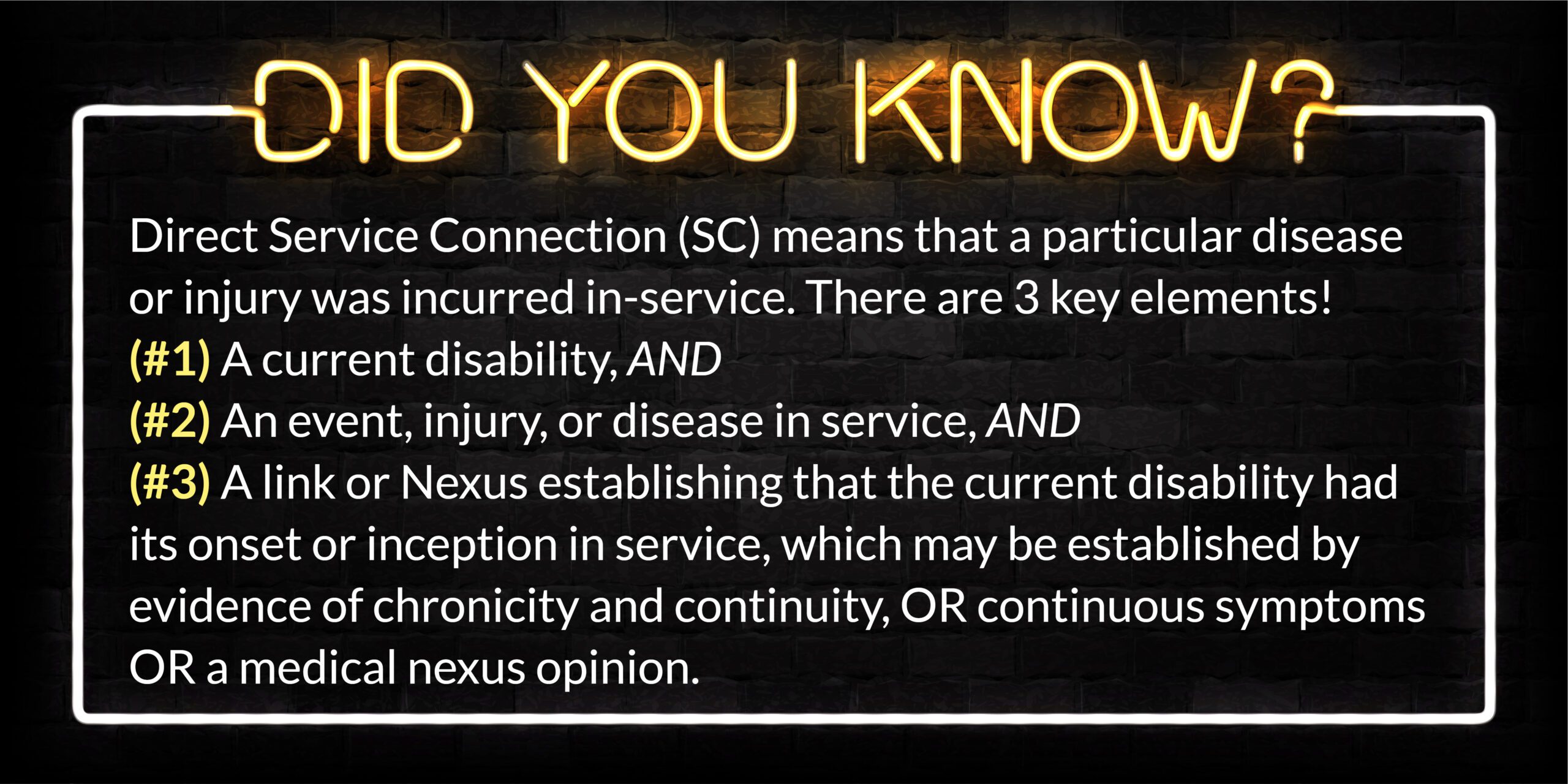
If you have a new disability condition that you think was caused or made worse by your active duty military service, you should open a new claim and select the option for “Direct Service Connection.”
For example, maybe you have Gastroesophageal Reflux Disease (GERD) that’s directly due to your military service, it’s in your Service Treatment Records, you suffer from it, but you never filed a claim for it.
It’s never too late to file a VA disability claim!
Pro Tip: You should read your Service Treatment Records in-detail to look for Active Problems, Diagnosis History, and Medical Evidence of (at least) subjective complaints of the disability condition you’re filing for. It helps to give the VA Rater specific page numbers of the disability condition in your records. If you never went to the doctor for the disability condition while on active duty, you must explain this in-detail, and talk about any in-service events, injuries, or illnesses that led to the development of your disability condition. A Nexus Letter is highly recommended for veterans who have been out of the military for more than 12 months.
How to File a New VA Claim for Direct Service Connection Online
Simply login to your VA.gov account and click “File a claim for compensation.”
Next, click the radio button that says: “I’m filing a claim for a new condition or for a condition that’s gotten worse.”
Before you submit your disability increase claim, make sure you’ve uploaded all supporting evidence necessary for the VA Rater to decide your claim.
Here’s a list of the evidence we recommend for a new VA disability claim for direct service connection:
- Military Personnel Records (Download a .pdf copy from MilConnect)
- Service Treatment Records (Download a .pdf copy from Tricare Online)
- VA Medical Records (Download a .pdf copy from MyHealtheVet)
- Private Medical Records (if applicable)
- X-Rays, MRI results, or other objective medical reports (if applicable)
- Statement in Support of a Claim on the VA Form 21-4138
- Buddy Letter on the VA Form 21-4138 or the VA Form 21-10210 – Lay & Witness Statement
- Nexus Letter (Independent Medical Opinion) for direct service connection with documentation of Severity of Symptoms
Pro Tip: You should be aware of The Caluza Triangle, which is named after a 1995 case Caluza v. Brown. The decision led to clarity on the 3 essential elements for service connection: (#1) Medical diagnosis of a disability condition, (#2) Evidence of an in-service event, injury, disease, or aggravation, AND (#3) “Nexus” (or link) between #1 and #2 via competent medical evidence. VA Claims Insider created a “Golden Circle” for VA disability benefits eligibility that covers a four factor: (#4) Severity of Symptoms in terms of frequency, severity, and duration.
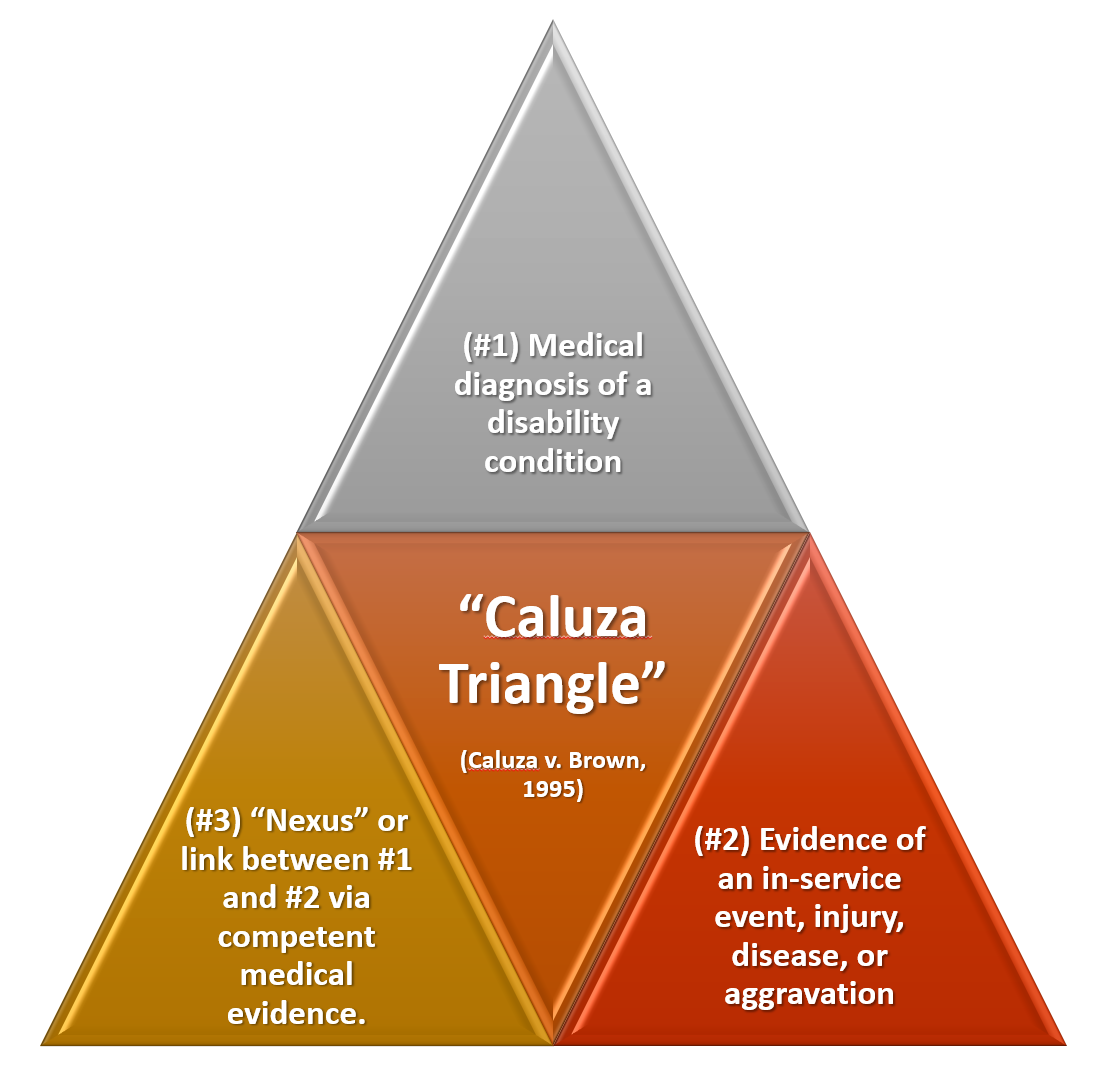
How to Go From 90 to 100 VA Rating Path #3. File for New Secondary Disability Conditions for Secondary Service Connection
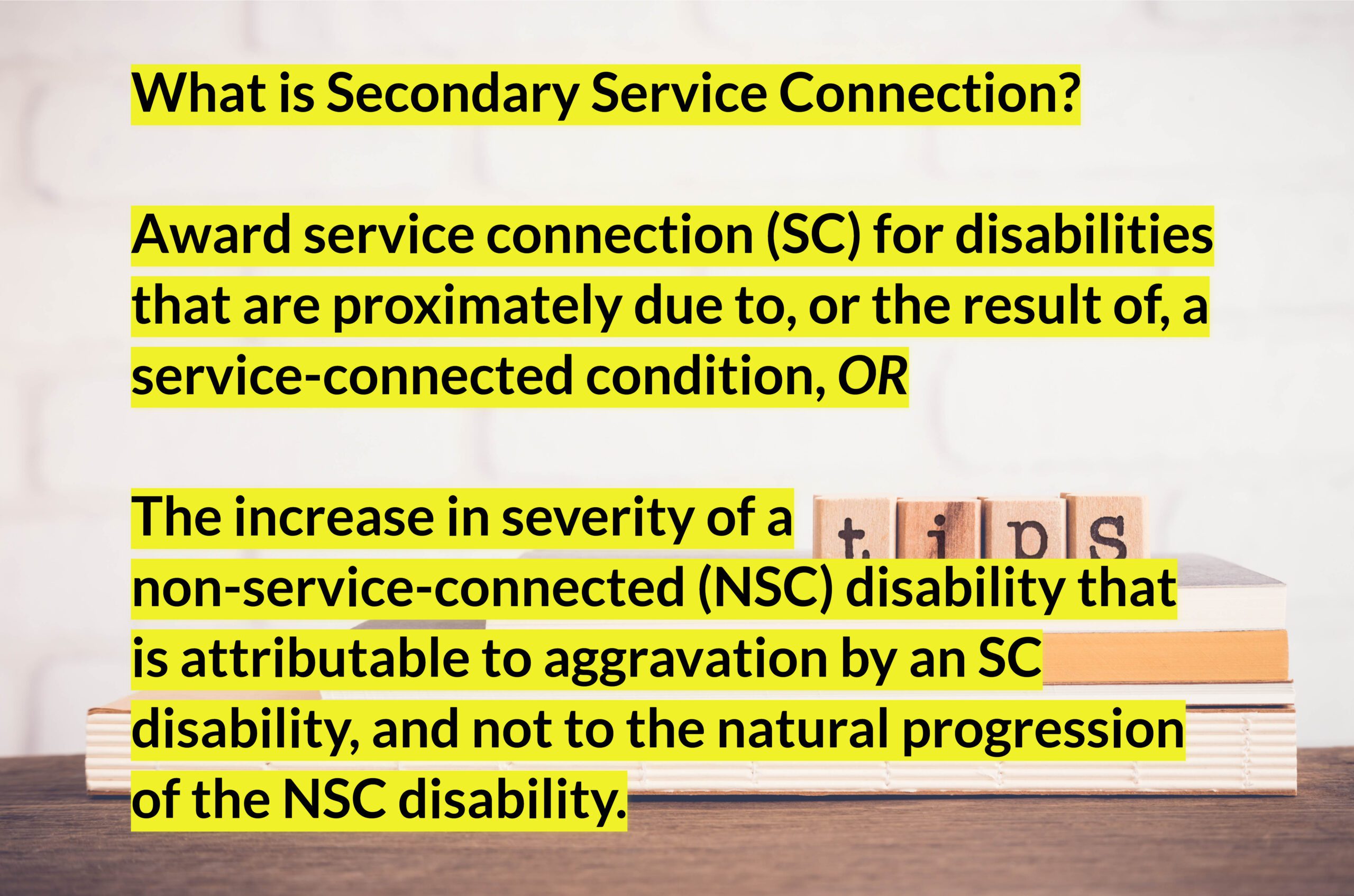
If you have a new secondary disability condition that you think was proximately due to or aggravated by another service connected disability rated at 0 percent or higher, you should open a new claim, add the new disability condition, and select the option for “Secondary Service Connection.”
For example, maybe you have Obstructive Sleep Apnea (OSA) that was aggravated by obesity/weight gain due to side effects of SSRI medications taken to manage your symptoms of service connected PTSD.
You can file a claim for Sleep Apnea secondary to PTSD with obesity/weight gain as an intermediate step for service connection.
Pro Tip: A VA Nexus Letter is highly recommended to help you prove secondary service connection. >> Click HERE NOW << to sign up for our premier education-based Coaching/Consulting program VA Claims Insider Elite, start free today, connect with a VA Claim Expert in minutes, and get high-quality Nexus Letters at reduced rates (if wanted and warranted by the evidence of record).
How to File a New VA Claim for Secondary Service Connection Online
Simply login to your VA.gov account and click “File a claim for compensation.”
Next, click the radio button that says: “I’m filing a claim for a new condition or for a condition that’s gotten worse.”
Finally, click radio button for service connection that says: “My disability was caused by another service-connected disability I already have. (For example, I have a limp that caused lower-back problems.)”
Before you submit your secondary disability claim, make sure you’ve uploaded all supporting evidence necessary for the VA Rater to decide your claim.
Here’s a list of the evidence we recommend for a new VA disability claim for secondary service connection:
- Military Personnel Records (Download a .pdf copy from MilConnect)
- Service Treatment Records (Download a .pdf copy from Tricare Online)
- VA Medical Records (Download a .pdf copy from MyHealtheVet)
- Private Medical Records (if applicable)
- Medical Research Studies (if applicable)
- X-Rays, MRI results, or other objective medical reports (if applicable)
- Statement in Support of a Claim on the VA Form 21-4138
- Buddy Letter on the VA Form 21-4138 or the VA Form 21-10210 – Lay & Witness Statement
- Nexus Letter (Independent Medical Opinion) for secondary service connection with documentation of Severity of Symptoms
Pro Tip: There are three key elements that must be satisfied to prove VA secondary service connection under the law:
- (#1) A medical diagnosis of the secondary VA disability you’re attempting to link to the current service connected disability (diagnosis must be documented in a medical record) AND
- (#2) A current service-connected primary disability (e.g., your current list of service connected disabilities from your VA.gov account) AND
- (#3) Medical Nexus Evidence establishing a connection between the service-connected primary condition and the current disability you’re trying to connect secondary (e.g., Migraines, Sleep Apnea, GERD, IBS, Erectile Disfunction / Female Sexual Arousal Disorder, Radiculopathy, etc.)
The FIRST part can be satisfied with any existing medical evidence in service treatment records, VA medical records, or private medical records.
The SECOND part can be satisfied with a veteran’s existing service-connected disability rated at 0% or higher.
The THIRD part, and often the missing link needed to establish secondary service connection, can be satisfied with a credible Medical Nexus Letter (Independent Medical Opinion) from a qualified medical provider.
How to Increase My VA Disability Rating Path #4. File a Supplemental Claim for Previously Denied Disability Conditions
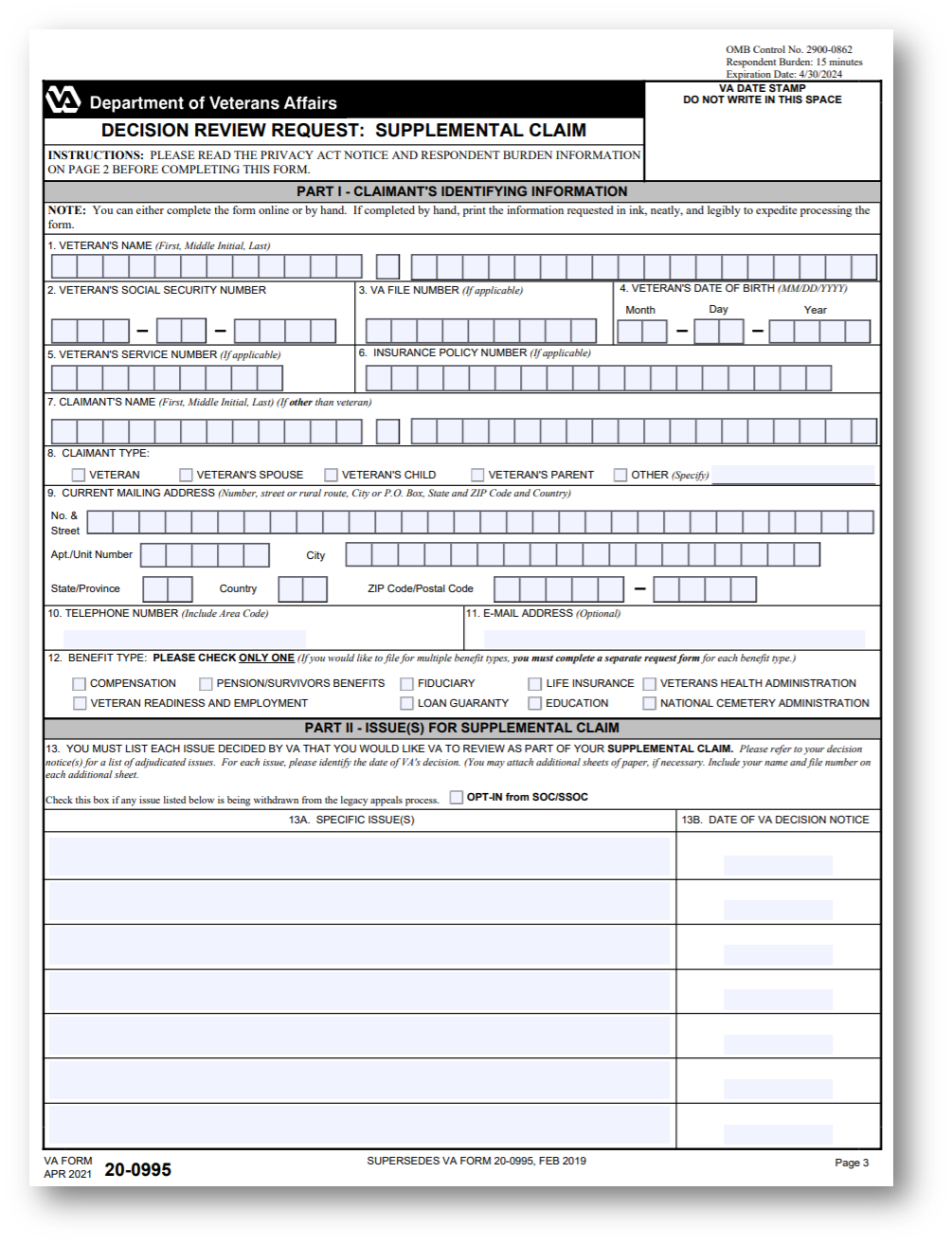
If you’ve been previously denied VA benefits, one of your appeal options is to file a Supplemental Claim.
You can file a Supplemental Claim at any time; however, we recommend you file within one year from the date on your VA Rating Decision Letter.
The main benefit of filing a Supplemental Claim is that you can upload new and relevant evidence not previously considered.
- New evidence is evidence not previously part of the actual record before agency adjudicators.
- Relevant evidence is information that tends to prove or disprove a matter at issue in a claim.
Examples of new and relevant evidence include new medical records, a new privately prepared DBQ, a new Nexus Letter, a new Statement in Support of a Claim, or a new Buddy Letter.
How to File a VA Supplemental Claim Online
First, download and complete the Decision Review Request form, Supplemental Claim (VA Form 20-0995).
Second, upload your completed VA Form 20-0995 along with all supporting evidence to the VA Direct Upload Veterans Claims Intake Program website.
After submission, your Supplemental Claim will appear as an “open claim” on VA.gov within 14 days.
Pro Tip: A Nexus Letter is highly recommended to help you prove your VA Supplemental Claim. >> Click HERE NOW << to sign up for our premier education-based Coaching/Consulting program VA Claims Insider Elite, start free today, connect with a VA Claim Expert in minutes, and get high-quality Nexus Letters at reduced rates (if wanted and warranted by the evidence of record).
Path #5. File for Presumptive Disability Conditions
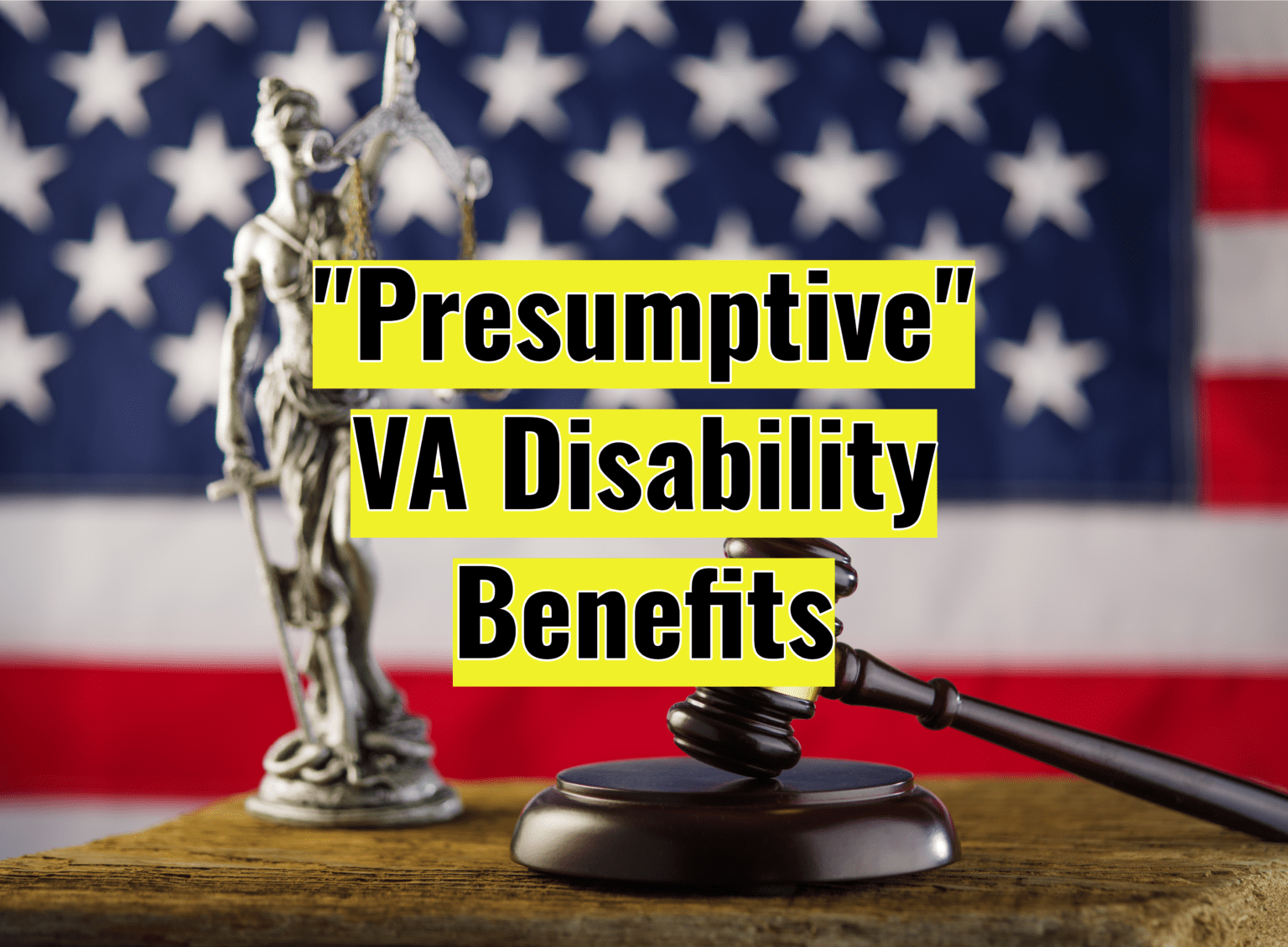
A presumptive disability condition is one that the VA “presumes” to be service-connected, even if there’s no specific causation or Nexus for service connection.
These claims are easy to win, assuming you can show via your DD 214 that you were deployed to an eligible location during a specific period, and you developed a qualifying disability condition as a result of your military service.
VA ratings for presumptive conditions range from 0% to 100%, depending on the condition and its severity of symptoms.
There are four main categories of veterans who qualify for Presumptive Disability Conditions: (1) Vietnam Veterans, (2) Atomic Veterans, (3) Gulf War Veterans, and (4) Gulf War Veterans exposed to Burn Pits.
How to File a VA Claim for Presumptive Disability Conditions Online
Simply login to your VA.gov account and click “File a claim for compensation.”
Next, click the radio button that says: “I’m filing a claim for a new condition or for a condition that’s gotten worse.”
Finally, click radio button for service connection that says: “My disability was caused by an injury or exposure during my military service.”
Before you submit your presumptive disability claim, make sure you’ve uploaded all supporting evidence necessary for the VA Rater to decide your claim.
Here’s a list of the evidence we recommend for a new VA disability claim for presumptive conditions:
- DD 214 (Make sure it clearly shows where you served and during what time period)
- Military Personnel Records (Download a .pdf copy from MilConnect)
- Service Treatment Records (Download a .pdf copy from Tricare Online)
- VA Medical Records (Download a .pdf copy from MyHealtheVet)
- Private Medical Records (if applicable)
- Medical Research Studies (if applicable)
- X-Rays, MRI results, or other objective medical reports (if applicable)
- Statement in Support of a Claim on the VA Form 21-4138
- Buddy Letter on the VA Form 21-4138 or the VA Form 21-10210 – Lay & Witness Statement
Pro Tip: In your Statement in Support of a Claim for Presumptive Service Connection, tell the VA Rater (#1) Where they can find your medical diagnosis of the presumptive disability by page number, (#2) Where to look on your DD 214 for the dates and location of your military deployments, and (#3) Your current Severity of Symptoms of the presumptive disability in terms of frequency, severity, and duration.
Increase VA Rating From 90 to 100 Percent Path #6. File for Total Disability Individual Unemployability (TDIU)

Veterans who can’t work because of their service connected disabilities might qualify for an extra-scheduler VA rating called “Individual Unemployability.”
Eligible veterans can get paid at the highest possible rating by law (100 percent VA rate), even if their combined VA rating is less than 100 percent.
Does your disability prevent you from holding down a steady job? (Note: This does not include being retired.)
If yes, you could be eligible to file a claim for Total Disability Individual Unemployability (TDIU).
You can file a claim for TDIU online at VA.gov after you’ve added new disabilities and click through to later screens.
To file a claim for Individual Unemployability, you’ll also need to fill out and upload the following:
- A Veteran’s Application for Increased Compensation Based on Unemployability (VA Form 21-8940) Download VA Form 21-8940, AND
- A Request for Employment Information in Connection with Claim for Disability Benefits (VA Form 21-4192) Download VA Form 21-4192.
Pro Tip: The law discusses unemployability as the inability to maintain “substantially gainful employment.” Marginal or odd jobs aren’t considered to be substantially gainful employment. The VA uses the Census’ published poverty tables to determine income levels. Currently, you must earn less than $14,097 per year from your job to be below the poverty line.
Want to Increase Your 90 VA Disability to 100% (Without the Pain of Fighting the VA for Years?)
- VA Claims Insider is a highly-rated, veteran-owned and operated business.
- 20,000+ disabled veterans served in our membership programs since 2016.
- 30% average VA rating increase for veterans who complete our #1 rated Elite program.
- Employs 144 teammates; comprised of 44 veterans and 12 military spouses.
- 4.7/5.0 average rating out of 4,000+ total reviews; over 3,000 5-star reviews.
You DESERVE a HIGHER VA rating.
Take advantage of a VA Claim Discovery Call with an experienced Team Member. Learn what you’ve been missing so you can FINALLY get the disability rating and compensation you’ve earned for your service.
About the Author

Brian Reese
Brian Reese is a world-renowned VA disability benefits expert and the #1 bestselling author of VA Claim Secrets and You Deserve It. Motivated by his own frustration with the VA claim process, Brian founded VA Claims Insider to help disabled veterans secure their VA disability compensation faster, regardless of their past struggles with the VA. Since 2013, he has positively impacted the lives of over 10 million military, veterans, and their families.
A former active-duty Air Force officer, Brian has extensive experience leading diverse teams in challenging international environments, including a combat tour in Afghanistan in 2011 supporting Operation ENDURING FREEDOM.
Brian is a Distinguished Graduate of Management from the United States Air Force Academy and earned his MBA from Oklahoma State University’s Spears School of Business, where he was a National Honor Scholar, ranking in the top 1% of his class.



